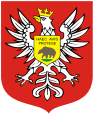Ostrołęka
| Ostrołęka | |||
|---|---|---|---|

|
|||
|
|||
| Coordinates: 53°4′N 21°34′E / 53.067°N 21.567°E | |||
| Country |
|
||
| Voivodeship | Masovian | ||
| County | city county | ||
| Established | 11th century | ||
| Town rights | 1373 | ||
| Government | |||
| • Mayor | Janusz Kotowski | ||
| Area | |||
| • Total | 29.00 km2 (11.20 sq mi) | ||
| Elevation | 92 m (302 ft) | ||
| Population (2014) | |||
| • Total | 52,792 | ||
| • Density | 1,800/km2 (4,700/sq mi) | ||
| Time zone | CET (UTC+1) | ||
| • Summer (DST) | CEST (UTC+2) | ||
| Postal code | 07-400 to 07-417 | ||
| Area code(s) | +48 029 | ||
| Vehicle registration plates | WO | ||
| Website | http://www.ostroleka.pl | ||
Ostrołęka [ɔstrɔˈwɛŋka] is a town in northeastern Poland on the Narew river, about 120 km (75 mi) northeast of Warsaw, with a population of 52,792 (2014) and an area of 29 km2 (11 sq. mls). The town is situated in the Masovian Voivodeship (since 1999), and it is the former capital of the Ostrołęka Voivodeship (1975–1998). Ostrołęka is currently the capital of both Ostrołęka County and Ostrołęka City County. Until the late 1980s, Ostrołęka used to be a local railroad junction, with four lines stemming from Ostrołęka railway station: eastwards to Łapy and Białystok, southwestwards to Tłuszcz and Warsaw, northwards to Wielbark and Olsztyn, and southwards to Małkinia.
The city's name refers to a sand-mud plain located on the left side of the Narew River which regularly flooded in the springtime throughout the centuries. A small fort was built on an island in the 11th or 12th Century, currently located just one kilometer west of the modern city center. The fort was one of few sparsely built fortifications along the Narew River at the time. A village developed surrounding the fort over time, and is associated today as the initial settlement of Ostrołęka. Despite the lack of an exact date for Ostrołęka's founding, the village was first mentioned in the Province Act of 1373 by Prince Siemowit III of Masovia, and therefore, the year 1373 has become the most commonly associated date in terms of the city's founding.
By the beginning of the 15th Century, Ostrołęka grew into an important economic center in the Duchy of Masovia for trade with the neighboring Teutonic Order. Wood, amber, and honey were the most commonly traded items. In 1526, the Duchy was incorporated into the Polish Kingdom. This resulted in an economic boom, most commonly associated to today as Ostrołęka's Golden Age. At this time, Queen Bona Sforza founded a folwark in Pomian – a neighboring settlement at the time, which currently finds itself situated well within the modern city's borders. The Golden Age lasted for approximately 40 years, whose conclusion is marked by three major catastrophes which struck in 1564 and 1571. In 1564, an epidemic seriously depopulated the town and surrounding regions. The same year, a fire tore through the town burning most of it down to the ground. In 1571, before the town had time to recuperate from the two previous catastrophes, another epidemic struck, further depopulating the region, officially marking the end of the town's Golden Age. Within 20 years, however, the town was rebuilt, including with the construction of Ostrołęka's first school. By the late 1590s, the town became the center of a big administrative district, approximately 1,980.5 km2 in size.
...
Wikipedia



